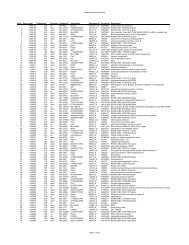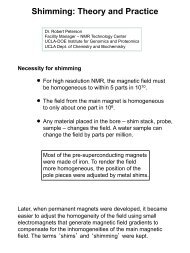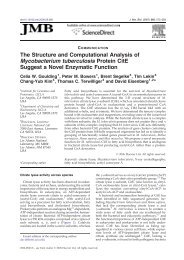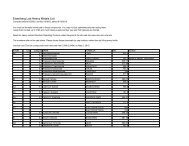Hydrophobic Moments and Protein Structure - UCLA-DOE
Hydrophobic Moments and Protein Structure - UCLA-DOE
Hydrophobic Moments and Protein Structure - UCLA-DOE
You also want an ePaper? Increase the reach of your titles
YUMPU automatically turns print PDFs into web optimized ePapers that Google loves.
118 HYDROPHOBIC MOMENTS<br />
thermal motion of lipid <strong>and</strong> water molecules at the surface, we expect that, averaged<br />
over the time of diffusion, this surface is not sharp, but may more accurately be<br />
thought of as a smoothly varying gradient in the hydrophobicity. This diffusionally<br />
averaged structure is similar in conception to the D-averaged structure for a liquid.'*<br />
The value of the hydrophobicity function M(x) is defined as +1 for an aqueous<br />
environment <strong>and</strong> -1 for an entirely hydrophobic one. As discussed above, the<br />
.<br />
.<br />
..........<br />
.............<br />
..............<br />
...................<br />
................<br />
...........<br />
.......................<br />
..........................<br />
...................<br />
..............<br />
.................<br />
.............<br />
............<br />
...........<br />
...........<br />
FIG. 8.-A highly schematic representation of the hydrophobicity function, M(x), plotted against<br />
position perpendicular to a membrane. M(x) is represented by the density of points: it is highest at the<br />
centre of the membrane, <strong>and</strong> falls off smoothly towards the aqueous interface at the top <strong>and</strong> bottom<br />
of the figure. At the top left is a surface-seeking helix, positioned so that its hydrophilic side chains<br />
( x ) are mainly in contact with the aqueous solvent <strong>and</strong> its hydrophobic side chains (0) are mainly in<br />
contact with the more hydrophobic region. At the right is a schematic representation of a membrane<br />
protein with hydrophobic side chains (0) in contact with the more hydrophobic region.<br />
" hydrophobicities " of the various amino acids are related to the free energies of<br />
transfer of their side chains from non-polar to polar environments. Therefore the<br />
product of the hydrophobicity of the environment M(x) <strong>and</strong> the hydrophobicity of an<br />
amino-acid yields, on a relative scale, a very rough estimate of the free energy of the<br />
amino-acid side chain in this environment. Low free energies (negative on this scale)<br />
result from hydrophobic side chains in apolar environments, <strong>and</strong> from hydrophilic<br />
side chains in polar environments. Thus a rough estimate for the free energy of a<br />
fixed protein structure in an environment with hydrophobicity described by the func-<br />
tion M(x) is<br />
GE CHiM(xi) (4)<br />
I<br />
in which the summation is over all amino-acid side chains in the structure. This<br />
expression neglects contributions from main-chain atoms, <strong>and</strong> assumes that all side-<br />
.











